9 Treating shingles and oral and genital herpes
Shingles
Shingles is an infection of a dermatomal or cranial nerve by the herpes zoster virus. The herpes virus establishes a latent infection in the nerve that lasts for the life of the host and may become active at times of stress or immune system compromise (Steiner 2007). The pain usually begins during the viral prodrome and can last up to 3 weeks before red raised lesions and blisters break out along the course of the nerve. Herpes simplex virus 1 (HSV1) is part of the same family of viruses and causes “cold sores” or lesions around the mouth. Herpes simplex virus (HSV2) lies dormant in the genitals and causes recurrent outbreaks of lesions in the genital or anal area. All are related to the varicella or chickenpox virus and the Epstein–Barr virus is included in this class of viruses (Liu 2006).
Herpes zoster, or shingles, is caused by the varicella zoster virus (VZV) and may be found in individuals of any age. It is more common in immunocompromised HIV-AIDS patients and bone marrow transplant recipients and in the elderly who have an 8–10-fold increase of incidence compared to those under age 60, presumably due to reduction of T-cell mediated immunity seen with aging. Diabetes mellitus, surgery, spinal anesthesia, malignancies, and conditions associated with immune suppression such as steroid therapy, and immune-suppressive agents serve as predisposing factors and triggers for the appearance of VZV or shingles (Steiner 2007).
One frequency has been found to treat shingles and both oral and genital herpes. The frequencies, 230Hz on channel A and 430Hz on channel B, were discovered among Dr. Van Gelder’s papers with the general description of being useful for viruses. When a patient came in with oral herpes in 1997 requesting treatment the frequency was used to determine if it would reduce the pain or change the normal course of the infection. The patient’s pain was gone within 20 minutes although the treatment continued for an hour. The pain never returned and the blisters were gone the next day. The following week another patient presented with oral herpes and had the same response but it took two treatments in two days to achieve a permanent result. In subsequent years numerous patients with genital herpes and oral herpes have both responded in exactly the same fashion. Neither frequency by itself creates this effect; both frequencies must be used as a combination delivered simultaneously.
The following month a patient presented with symptoms of nerve pain but no mechanism of injury that would create nerve pain. He stated that he woke up in pain and had no idea what he had done to cause it. When the protocols for inflammation in the nerve did not reduce the patient’s nerve pain, the frequency that had reduced the oral herpes virus was used on the chance that the frequency might be useful for the herpes virus in general and that the real cause of the pain might be shingles. The nerve pain started dropping immediately, was eliminated in 15 minutes, and the patient was treated for 60 minutes because he was sleeping and seemed too peaceful to be disturbed. He called the next day saying that the pain stayed down for about 8 hours and gradually returned but at a lesser level. He requested another treatment. He had the same response. The pain was eliminated in 15 minutes, the patient fell asleep and he was treated for an hour. He called the next day saying that the pain had been quiet over night and had come back at a much reduced level and asked if he could be treated again. He was treated for an hour on the third day. The mild pain was eliminated in 5 minutes; the patient fell asleep for an hour while being treated. And this time the pain did not return.
The next time a patient came in with dermatomal nerve pain and had no history of injury or activity that would explain nerve pain the shingles/herpes frequency was used and the exact same response occurred. The pain was eliminated in 15 minutes. The patient was treated for an hour because he slept for an hour. The pain relief lasted about 6 hours after the first treatment, overnight at the second treatment, and became permanent after the third treatment. The pain returned at a much reduced level each time it was treated. One hour of treatment three days in a row prevented the blisters from breaking out and aborted the attack of what was presumed to be shingles in the prodrome.
If the vesicles of shingles have already appeared as either a rash or as blisters along the course of the nerve root the same frequency, 230 / 430, and treatment protocol are effective but the effect is not as dramatic. The pain is eliminated within 30 minutes and 3 hours of treatment within 3 days dries up the blisters, reduces the pain when it reoccurs and shortens the course from approximately 4 weeks to 3–5 days. The protocol has been modified by some practitioners to treat with 230 / 430 for 2 hours on one day only and the results have been similar. Pain is eliminated; blisters dry up and rash disappears in 3–5 days. No cases of post-herpetic neuralgia have been reported following treatment with FSM for shingles. Some practitioners have used this frequency to treat the aching and fatigue caused by recurrent episodes of Epstein–Barr virus.
This frequency combination is and has been so effective that it has been used to make a tentative diagnosis. The frequencies for reducing inflammation in the nerve (40 / 396) that are effective in dermatomal nerve pain will not reduce nerve pain caused by the herpes virus and may actually increase herpes generated pain. If this frequency, 230 / 430, takes away dermatomal nerve pain, or burning pain at the mouth or genitals then it is almost certain that the pain is being caused by one of the family of herpes viruses. There are hundreds of case reports describing positive effects from FSM practitioners around the US, the UK and Australia. The patients are always blinded to the frequency being used. No other frequency combination has been found that creates this effect. No patients with symptoms related to this virus have been found who do not respond to it. Controlled trials have been designed but none have been funded or carried out.
The immediate pain reduction and lasting pain relief suggest that something is happening to interfere with either viral structure or replication. The mechanism for this effect is unknown. Several mechanisms have been proposed but none have been tested. The herpes family of DNA viruses has a double stranded DNA molecule located within an icosapentahedral capsid surrounded by an amorphous protein material which is in turn encapsulated by an envelope that consists of polyamines, lipids and glycoproteins. The glycoproteins give the virus its distinctive properties and provide the antigens to which the host immune system can respond (Steiner 2007).
It is possible that some part of the viral capsid, the crystalline structure of the viral polymerases or the glycoprotein envelope, resonates at the frequencies created by 230Hz and 430Hz in an interferential field and is disrupted by the resonance. The frequencies found in the interferential field created by 230Hz and 430Hz would include coherent frequencies of 230Hz, 430Hz, 660Hz, and 200Hz. Any or all of these frequencies may participate in the observed clinical effect. When the frequency combination encounters the viral structure it is possible that it resonates with either the capsid membrane or glycoproteins in such a way as to dismantle it or change its structure in such a way that it cannot maintain its relationship with the nerve. It is also possible that the frequency resonates with the nerve in such a way that it makes viral attachment impossible, releases the virus into the circulation and makes it available to be dismantled by the immune system. This mechanism seems less likely because of the speed of pain relief and the length of pain reduction but it is possible.
Post-herpetic neuralgia (PHN) is more difficult to treat and does not respond to the protocols for shingles. The virus is gone within weeks of the active infection and the neuralgia may be caused by viral damage to the nerve. The treatment for PHN is focused on inflammation, calcium influx into the nerve and scar tissue between the nerve and the surrounding fascia, and reduction of central amplification created by deafferentation of the peripheral nerve. Thoracic nerve roots have sympathetic involvement which complicates PHN symptoms and treatment. The protocols for neuropathic pain discussed in Chapter 3 may be useful in PHN but it can be challenging to treat.
Shingles diagnosis
Shingles should be suspected when the history includes moderate dermatomal pain in any nerve root or pain in the head and scalp with no mechanism of injury that would account for it. Patients may rationalize the cause of the pain as being from some unusual activity such as working in the garden or carrying and lifting suitcases or “turning the wrong way”. However, the pain is generally more severe than would be reasonable for any injury that would have been caused by some trivial activity.
For example a recreational weight-lifter thought he had a severely painful shoulder injury from lifting 40-pound suitcases because he woke up in pain after flying to his vacation destination and carrying the suitcases in the airport. It is not reasonable for someone who can repeatedly lift 180 pounds over his head to have level 7/10 pain created by lifting a 40-pound suitcase twice in one day. In this example, a sensory examination with a pin wheel revealed nerve hyperesthesia in the C4 and C5 dermatomes located on the shoulder. A simple sensory examination for sharp performed with a pin, a pinwheel or a sharp object like a paper clip will show the nerve to be irritated, hypersensitive and painful. If the history does not include a mechanism of injury for the disc or a traction injury that seems reasonable, then a treatment trial of 15 minutes with 230 / 430 can be used to confirm the suspicion. The treatment has been found to be effective enough that it may be used for differential diagnosis. If 230 / 430, the frequency for shingles and herpes virus, takes the pain away then the pain is caused by shingles until proven otherwise. The frequency is not useful for any other condition.
The majority of shingles cases in the elderly occur in thoracic nerve roots although any dorsal root ganglion may be involved (Bradley 2000). Thoracic nerve pain may present as abdominal pain or chest pain and may be mistaken for pain of visceral origin. A sensory examination for skin hyperesthesia, the first sign of nerve irritability, is a simple way to determine neural involvement and may avoid expensive and invasive diagnostic testing aimed at discovering a visceral cause for the pain.
Patients who have a history of oral or genital herpes are usually aware of the sensations experienced in the prodrome. These are usually described as burning or itching and there will be some local redness and swelling in the skin over the impending vesicle. If the diagnosis is uncertain, it may be prudent to wait for the lesion to erupt and culture it to determine if it is bacterial or viral or a 30-minute treatment trial with 230 / 430 can be done. After 10 years experience using this frequency in hundreds of clinical settings in several countries, it has been said that if the lesion is caused by the herpes virus treatment with 230 / 430 will change the pain and the course. If the frequency doesn’t relieve the pain then a culture or reassessment is required to determine the source of the lesion.
Physical examination
Perform a sensory examination with a pin, pinwheel or a sharp object such as a paper clip. The sensory exam will show hyperesthesia in one or more dermatomes. Shingles should be considered and ruled out by doing a simple sensory examination any time there is moderate pain on the limbs, trunk, abdomen or head.
• The patient must be hydrated to benefit from microcurrent treatment.
• Hydrated means 1 to 2 quarts of water consumed in the 2 to 4 hours preceding treatment.
• Athletes and patients with more muscle mass seem to need more water than the average patient.
• The elderly tend to be chronically dehydrated and may need to hydrate for several days prior to treatment in addition to the water consumed on the day of treatment.
• DO NOT accept the statement, “I drink lots of water”.
• ASK “How much water, and in what form, did you drink today before you came in?”.
• Coffee, caffeinated tea, carbonated cola beverages do not count as water.
Treating shingles
A/B pair for shingles and herpes
Application
• Current level: 100–300μamps. Use lower current levels for very small or debilitated patients. Use higher current levels for larger or very muscular patients. In general higher current levels reduce pain more quickly. Do not use more than 500μamps as animal studies suggest that current levels above 500μamps reduce ATP formation while current levels below 500μamps increase ATP.
• ± Alternating or Biphasic Current: Current is used in alternating mode for treatment of shingles and herpes. “Alternating DC current” is actually DC (direct) current that alternates its polarity from positive to negative during the machine duty cycle.
Waveslope
• Use a moderate to gentle waveslope.
• The waveslope refers to the rate of increase of current in the wave as it rises in alternating mode from zero up to the treatment current level every 2.5 seconds on the Precision Microcurrent. Other microcurrent instruments may have slightly different duty cycles and the waveform may change more or less frequently. A sharp waveslope has a very steep leading edge on the waveform, indicating a very sharp increase in current. A gentle waveslope has a very gradual leading edge on the waveform, indicating a gradual increase in current.
• Use a moderate to sharp waveslope for chronic pain. Use a gentle waveslope for acute pain or new injuries. A sharp waveslope is irritating in new injuries. Different microcurrent devices may provide different wave shapes and waveslopes but the reader may find them to be equivalent.
Technique
This is unattended treatment. There is no manual technique involved. Position the patient; position the contacts as described, set the frequency and turn on the unit; stay for a few minutes to ensure that the current is conducting and as soon as the patient relaxes and the pain begins to fall the practitioner may leave the room. Someone should check on the patient occasionally during the 1–2-hour treatment time. The patient may fall asleep and should be positioned comfortably and safely for this predictable response.
Lead placement for shingles
• Place the positive leads from channel A and channel B at the spine or in a warm wet contact that wraps the spine where the involved nerve roots exits.
• Place negative leads from channel A and channel B at the end of the involved nerve root.
• FSM typically uses graphite gloves to conduct the current. The graphite gloves need to be kept moist so they conduct the current comfortably. The contact for nerve treatment needs to wrap around the outflow of the nerve root as it exits from the spine. The graphite gloves, bare leads or alligator clips on leads can be placed in small warm wet towels or fabric sleeves.
• The positive leads in wet fabric contacts can cover a larger area and allow a broad contact around the neck or along the spine at the exiting nerve root.
• The negative leads wrap around the end of the dermatome being treated.
NOTE: The treatment is more effective if the negative lead is placed precisely at the end of the affected nerve root so it provides optimal current density. For example if the virus affects the C4 and C5 nerve root the positive contacts should wrap the spine and the negative contacts should wrap the upper arm just above the elbow.
• For the C2 nerve root place the positive leads in a wet contact around the neck and place the negative leads in a wet contact at the top of the head along a line between the ears.
• For the ophthalmic branch of Cranial V place one glove in a wet contact around the neck and the other glove in a wet contact placed from a line just behind the ears across the top of the head to the eye. Care should be taken not to let the contact touch the eye itself but it can be placed over the closed eyelid.
• For a patient who develops a headache or has shingles pain in multiple dermatomes there is reason to suspect spinal cord involvement. Place the red leads in a wet contact around the neck and the black leads in a wet contact around the feet or at the waist.

PRECAUTION: Herpes simplex encephalitis (HSE) is a very serious form of herpes infection with serious consequences and sequellae. HSE is a medical emergency and the prognosis is dependent on early initiation of treatment. If HSE is suspected due to headache, the presence of fever, personality changes, confusion, disorientation, seizures or focal neurological signs such as hemiparesis, oral antiviral therapy and medically appropriate supportive measures should be instituted without delay.
FSM may be of benefit in these cases as an adjunct but its use must not delay appropriate conventional therapy in this serious condition. If medical treatment or diagnostic measures are not available for some unavoidable reason then FSM may be used as sole temporary treatment if and only if no other treatment is available and only until such time as appropriate treatment becomes available.
See the placement as shown in the photographs (Figs 9.1 to 9.9).
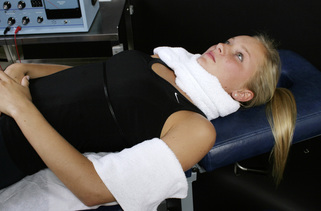
Figure 9.1 • Place the positive leads graphite glove wrapped in a warm wet fabric contact that is wrapped around the neck. Place the negative leads graphite glove in a warm wet fabric contact (hand towel) that is wrapped at the end of the involved nerve root, in this case the C4 and C5 dermatomes.
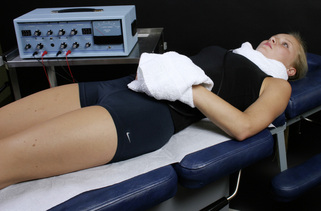
Figure 9.2 • Place the positive leads graphite glove wrapped in a warm wet fabric contact that is wrapped around the neck. Place the negative leads graphite glove in a warm wet fabric contact (hand towel) that is wrapped at the end of the involved nerve root, in this case the C6, C7 and C8 nerve roots.

Figure 9.3 • Place the positive leads graphite glove wrapped in a warm wet fabric contact that is wrapped around the neck. Place the negative leads graphite glove wrapped in a warm wet fabric contact (face cloth) at the end of the C2 dermatome. The wet face cloth must make contact with the skin. This usually involves parting the hair and watching the machine to ensure that current is flowing. The contact may be propped, wrapped or clipped in place but occasionally it needs to be held by someone for the length of the treatment to make sure that it maintains conductivity.
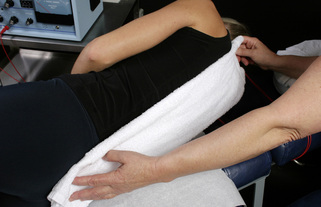
Figure 9.4 • Place the positive leads graphite glove wrapped in a warm wet fabric contact (hand towel) that is placed lengthwise under the patient’s thoracic spine. Alligator clips may also be attached to the fabric contact as shown in Chapter 11. The treatment will last for 1–2 hours and the patient is more likely to be comfortable lying supine but may be treated in any comfortable position. Some patients have been treated while sitting in a recliner chair.
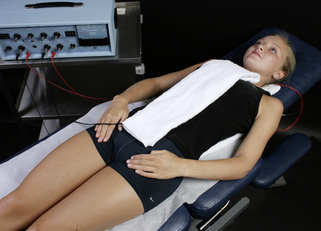
Figure 9.5 • Place the negative leads graphite glove wrapped in a warm wet fabric contact (hand towel) that is placed lengthwise down the trunk from collar bone to pubic bone. This allows treatment of several nerve roots simultaneously. The patient may be treated prone, supine or seated as long as the contact maintains good conductivity with the skin.

Figure 9.6 • Place the positive leads graphite glove or two leads attached with alligator clips to a warm wet fabric contact placed under the patient’s low back making sure that it contacts the spine at T12 through L4. Place the negative leads graphite glove in a warm wet fabric contact (hand towel) that is laid lengthwise from L1 on the abdomen to L3 at the knee.
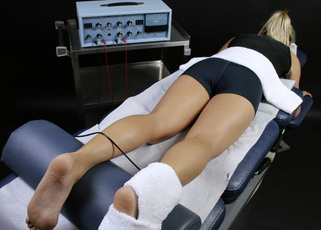
Figure 9.7 • Place the positive leads graphite glove or two leads attached with alligator clips to a warm wet fabric contact placed under the patient’s low back making sure that it contacts the spine at L3 through S2. Place the negative leads graphite glove in a warm wet fabric contact (hand towel) that is wrapped around the distal leg and foot to provide current flow to all of the involved dermatomes. This patient is shown being treated prone but may be more comfortable positioned supine since they will be in this position for as much as 2 hours. If the patient has facet syndrome they most certainly cannot lay prone and must be positioned supine with the knees up and back flat. Disc patients may prefer lying prone. Patients are often treated in a recliner chair so they can be positioned comfortably and safely while they sleep for the 2-hour treatment.
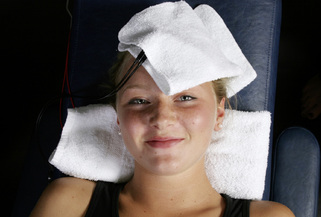
Figure 9.8 • Place the positive leads graphite glove in a warm wet contact that is under the patient’s neck at the suboccipitals and mastoid process. Place the negative leads glove wrapped in a warm wet contact along the path of the ophthalmic branch of Cranial V, from a line just behind the ears across the top of the head to the eye. Care should be taken not to let the contact touch the eye itself but it can be placed over the closed eyelid.
Maintaining skin contact and conductivity in patients who have short hair is easy. Maintaining skin contact and conductivity in patients with longer hair takes more effort. The contacts need to be very wet instead of being well wrung out; the hair needs to be parted so the fabric is in direct contact with the scalp and the hair may even need to be wet to ensure adequate conductivity. Check conductivity indicators to ensure that current is flowing before leaving the patient unattended. The set up can be a bit messy and wet but the outcome is well worth the inconvenience.
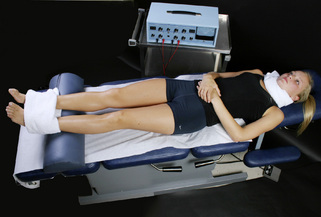
Figure 9.9 • This rare shingles distribution has only been seen once in the author’s practice but this contact placement was effective in reducing pain and eliminating the blisters after three treatments in a 3-day period. Place the positive leads graphite glove or electrodes in alligator clips in a warm wet fabric contact (hand towel) that is wrapped around the neck. Place the negative leads graphite glove or electrode in alligator clips in a warm wet fabric contact (hand towel) wrapped around the patient’s feet.
Treatment time
Treat for 60 minutes on the first treatment and for each of the two subsequent treatments. Some practitioners use a single 2-hour treatment. Shorter treatments are not effective.
• Prodrome: If diagnosis is made early and treatment begins in the shingles prodrome, pain reduction begins within 10–20 minutes. Pain will return at a lower level about 6–12 hours after the first treatment. One hour of treatment on three consecutive days should abort the attack and the blisters should not appear.
• Active infection: If the patient is past the prodrome and the blisters or rash are already present, treatment should reduce or eliminate the pain in approximately 20 minutes but it may take as long as 60 minutes. Treat the patient for 60 minutes a day for 3 days or for as many days as necessary for the pain relief to become permanent. In general the blisters will scab over and the typical 6-week shingles course will be shortened to 3–5 days.
Shingles case report
The patient was an 85-year-old male whose scalp rash had been diagnosed as actinic keratosis by his dermatologist one week previous to his visit to the chiropractor’s office. The medication for the actinic keratosis was not helping his scalp pain and seemed in fact to be making it worse. The patient presented requesting FSM treatment for his scalp pain. Based on the diagnosis of actinic keratosis, the FSM treatment was directed at reducing inflammation in the skin and scalp with one contact on the back of the neck and one contact in a wet cloth on the top of the head covering the rash and the frequency was set at 40Hz on channel A and 116Hz on channel B. After 5 minutes the treatment to “reduce inflammation” caused the patient to complain that the cloth conducting the current on the scalp was too rough and irritating to the skin and seemed to be worsening the pain. In general, the body uses inflammation to fight infection and a treatment whose purpose is to reduce inflammation will only make the pain worse if there is infection present.
Based on the report of increasing pain, the practitioner reassessed the location of the rash, considered the patient’s age and general frail health, dismissed the dermatologist’s diagnosis and changed the diagnosis to shingles in the ophthalmic branch of the fifth cranial nerve (V). The frequency was changed to 230Hz on channel A and 430Hz on channel B but no change was made to the position of the contacts or the current level. The pain stopped worsening, began to diminish within 10 minutes and after 30 minutes the patient was pain free. Treatment was continued for 90 minutes on the first day. The patient returned for one 60-minute treatment on each of the next two days but he was pain free after the first treatment. On the second day he reported that his eye “felt funny” although there was no change in vision. The scalp contact was moved forward until it covered the closed eyelid and the patient reported that the funny feeling was gone within 20 minutes. The eye symptoms did not return and the contacts were moved back from the eyelid to cover the scalp only for the third treatment. By the third day, the rash assumed the appearance of scabs sprinkled over the distribution of the ophthalmic branch of V and the scabs resolved with no further pain within 5 days.
Oral and genital herpes
Treatment protocol for oral and genital herpes
A/B pair for herpes
Lead placement:
• Oral herpes: Place one graphite glove or electrode contact in a wet washcloth or small piece of fabric over the mouth. The fabric should be thoroughly wet but wrung out so it is not dripping. Place the other contact under the upper thoracic spine or behind the neck.
• Genital herpes: Place one graphite glove or electrode contact in a warm wet cloth under the sacrum and low back. Place the other graphite glove or electrode contact in a warm wet washcloth or small piece of fabric and place it over the vulva or genitals draping it from the pubic bone as far posterior as necessary. Include the anus if the lesions extend that far or if the history suggests that area may be infected. The fabric should be thoroughly wet but wrung out so it is not dripping.

Precaution: Treatment with this frequency has so far been universally effective at alleviating pain and skin lesions in both shingles and herpes; however, no controlled trials have been performed at this time and there is no information about its effect on viral shedding. Common sense and appropriate risk assessment should be applied to each individual case and the practitioner should decide whether to prescribe accepted oral antiviral medications in at-risk patients and use FSM treatment as an adjunct for pain management and to shorten the course of the infection on a case by case basis. FSM may be helpful in treating patients with renal problems who are not good candidates for antiviral therapy.
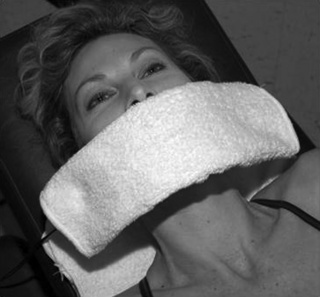
Figure 9.10 • Oral herpes: Place the positive leads graphite glove or electrode alligator clip contact in a wet wash cloth or small piece of fabric under the upper thoracic spine or behind the neck. Place the negative leads contact over the mouth. The fabric should be thoroughly wet but wrung out so it is not dripping.
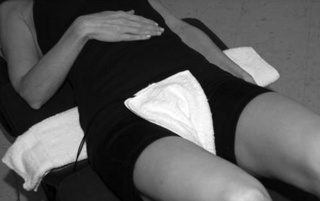
Figure 9.11 • Place the positive leads graphite glove or electrode alligator clip contact in a warm wet cloth under the sacrum and low back. Place the negative leads graphite glove or electrode alligator clip contact in a warm wet washcloth or small piece of fabric and place it over the vulva or genitals, draping it from the pubic bone as far posterior as necessary. Include the anus if the lesions extend that far or if the history suggests that area may be infected. The fabric should be thoroughly wet but wrung out so it is not dripping.
Oral herpes case report
The patient was a 27-year-old woman who presented with a severe outbreak of oral herpes. There were lesions visible encircling her mouth and covering most of the mucosal surfaces inside her mouth. She had pain with swallowing suggesting that there were lesions in her throat. She had a slight fever of 101 degrees Fahrenheit. She had a history of oral herpes but had never before had an attack this severe.
She was treated with microcurrent set at 230Hz on channel A and 430Hz on channel B. The graphite gloves were placed in a warm wet washcloth that was placed over her mouth as she lay supine. The other graphite glove was placed under her neck. The current level was set at 100μamps and the waveslope was set at moderate (5/10). The pain began to decline within 10 minutes and the patient fell asleep. She had the time and the treatment room she occupied was not needed and so she was allowed to sleep until she awoke 3 hours later.
At the end of the 3-hour treatment half of the blisters in her mouth had resolved, her throat was no longer sore, her temperature was normal and she was pain free. The rest of the lesions resolved with no further treatment by the next day. There has never been another case treated for this length of time but this isolated case is intriguing. It may be that 3 hours initial treatment may be sufficient to resolve shingles as well instead of 3 hours spread over three consecutive days.
Post-herpetic neuralgia
Post-herpetic neuralgia (PHN) is the most common neurological complication of herpes zoster. PHN is defined as pain in the distribution of the rash which persists beyond 4–6 weeks following shingles infection. The risk for PHN increases with age and almost half of patients over age 60 will develop PHN following the acute infection. The pain involves the affected nerve root; the constant pain is described as severe, burning, and stabbing and can be so disturbing as to lead to severe depression. PHN is said to be the leading cause of suicide in patients over the age of 65. The mechanisms behind PHN are not clear and there is speculation that it may be due to persistent viral infection in the dorsal root ganglia (DRG), structural damage to the DRG or the nerve following viral infection, or central mechanisms including long-term enhancement in synaptic excitability in the brain and the spinal cord or changes in the control mechanisms that allow both spinal cord and central sensitization.
Treating PHN requires a different strategy and is much more difficult than treating the acute phase of shingles but has been accomplished successfully often enough that treatment should be attempted. The treatment would be similar to that for chronic nerve pain with adhesions and central sensitization and is found in Chapter 3. The information required for a comprehensive treatment of this topic is beyond the scope of this book.
Bradley W.G., Darhoff R.B., Fenichel G.M., Marsden C.D. Neurology in clinical practice, third ed. Boston: Butterworth Heinemann, 2000.
Liu S., Knafels J.D., Chang J.S., et al. Crystal structure of the herpes simplex virus 1 DNA polymerase. J. Biol. Chem.. 2006;281:18193-18200.
Steiner I., Kennedy P.G., Pachner A.R. The neurotropic herpes viruses: herpes simplex and varicella-zoster. Lancet Neurol.. 2007;6:1015-1028.
